To avoid legal issues with urban bamboo, install root barriers extending at least 30 inches deep and 12 inches from your property line. Choose clumping varieties over running bamboo, which spreads aggressively and can trigger liability claims from neighbors. Document all containment efforts with photographs and receipts, maintain annual inspections, and secure specialized liability insurance that covers invasive species. Your proactive approach to bamboo management will protect you from costly litigation and neighborhood disputes.
Understanding the Legal Risks of Running Bamboo
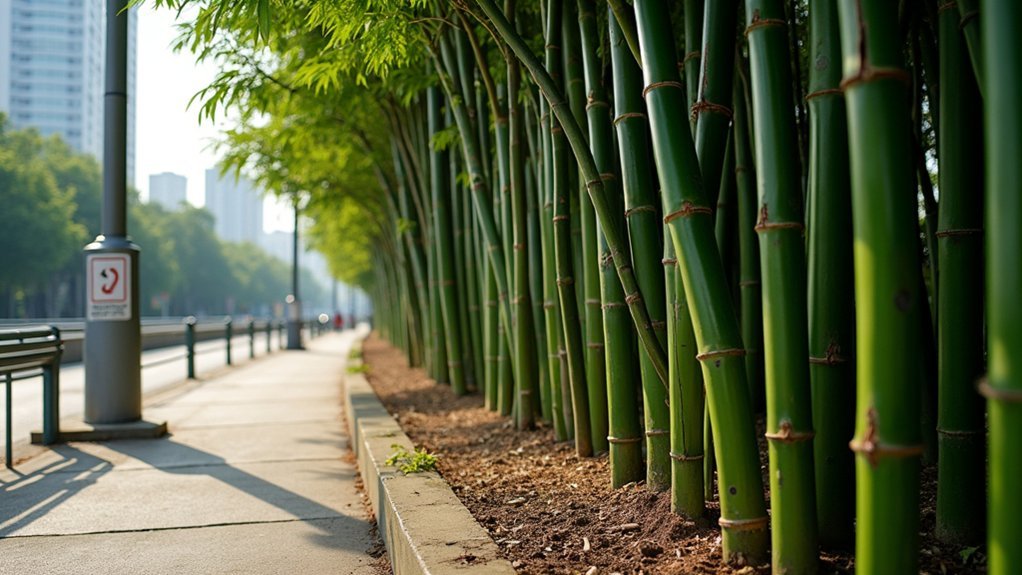
While bamboo might seem like an attractive privacy solution for urban properties, its invasive nature carries considerable legal consequences.
As a New York property owner, you’re potentially liable for bamboo encroachment onto neighboring properties, even if you planted it before the 2015 ban.
Running bamboo’s aggressive rhizomes can spread over 3 meters underground, triggering property disputes and lawsuits. Courts have established precedent for negligence claims when owners fail to contain their bamboo, as seen in the Sultan vs. King case.
Your bamboo plantation could legally constitute a nuisance if it interferes with neighbors’ property enjoyment.
To protect yourself, install proper root barriers and monitor boundaries regularly. Early identification and prompt removal of spreading bamboo will considerably reduce your legal exposure and prevent costly litigation with neighbors.
Types of Bamboo and Their Legal Implications
Because not all bamboo varieties pose the same legal risks, you’ll need to understand the critical distinction between running and clumping types.
Running bamboo species, with their aggressive bamboo spread through underground rhizomes, are frequently classified as invasive species and can trigger property disputes like the Sultan-King case in New York.
- Running bamboo: Legally problematic due to rapid spreading, potentially resulting in nuisance and trespass claims even if planted before local bans
- Clumping bamboo: Generally contained growth pattern with minimal legal risk to neighboring properties
- Regulated varieties: Subject to local restrictions that vary by municipality, requiring research before planting
Property Line Considerations for Bamboo Planting
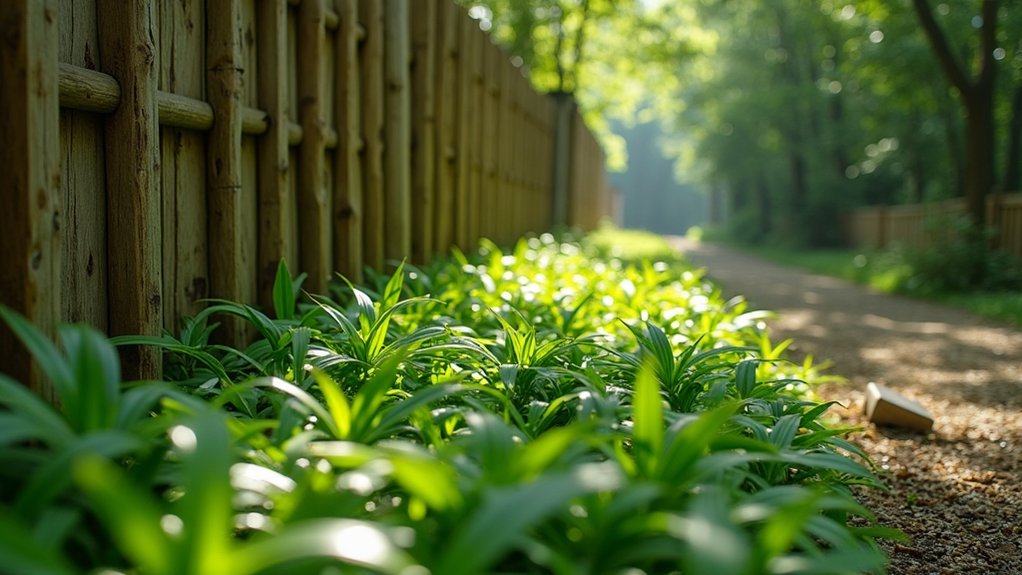
You’ll need to carefully assess your property boundaries before planting bamboo, as the aggressive rhizome system can cross into neighboring lands and create legal liabilities.
Installing proper containment systems, such as 30-inch deep polypropylene barriers around your bamboo, isn’t just good practice—it’s often required by local ordinances to prevent encroachment.
Remember to document your compliance with these requirements through photographs and receipts, which can serve as evidence of your due diligence should disputes arise with adjacent property owners.
Boundary Rights and Responsibilities
Although bamboo creates an attractive natural barrier, understanding your property boundaries remains essential before planting this potentially invasive species.
As a property owner, you’re legally responsible for preventing bamboo from crossing boundary lines and potentially damaging neighboring structures or landscapes. When bamboo roots invade adjacent properties, you could face trespass claims, nuisance lawsuits, and financial liability for damages.
To protect your boundary rights and prevent bamboo encroachment:
- Install professional-grade root barriers extending at least 30 inches deep around planting areas
- Regularly inspect and maintain containment systems, especially after heavy rainfall when bamboo growth accelerates
- Communicate proactively with neighbors about your bamboo plans and containment strategies
Remember to check local ordinances regarding invasive species before planting, as some municipalities have specific regulations governing bamboo cultivation and maintenance requirements.
Containment System Requirements
Proper containment systems represent the first line of defense against potential legal issues when planting bamboo near property boundaries. You’ll need barriers that extend at least 24 inches deep to effectively prevent rhizomes from escaping your yard.
The aggressive root system of running bamboo species can travel over 10 feet in length, potentially creating neighbor conflicts and legal liability.
Always install barriers at least 12 inches away from your property line to create a vital buffer zone. This separation helps guarantee that even if some rhizomes attempt to spread, they won’t immediately cross into neighboring properties.
Check your local regulations before planting, as ordinances regarding bamboo containment vary considerably between municipalities.
Remember that regular monitoring and maintenance aren’t optional—they’re essential for avoiding trespass or nuisance claims from adjacent property owners.
Effective Root Barrier Systems for Legal Compliance
When installing bamboo barriers, nothing protects you from potential lawsuits more effectively than a properly designed root barrier system.
To prevent the spread of bamboo onto neighboring properties, you’ll need barriers made from impermeable materials installed at least 60cm deep. This containment method is especially vital for running bamboo varieties with rhizomes that can extend over 3 meters.
- Identify your bamboo species first—different varieties require specific barrier solutions based on their invasiveness
- Consider professional installation services to guarantee proper placement and construction, reducing your legal liability
- Commit to regular maintenance by checking for escaping rhizomes and maintaining barrier integrity
Case Studies of Bamboo Encroachment Lawsuits
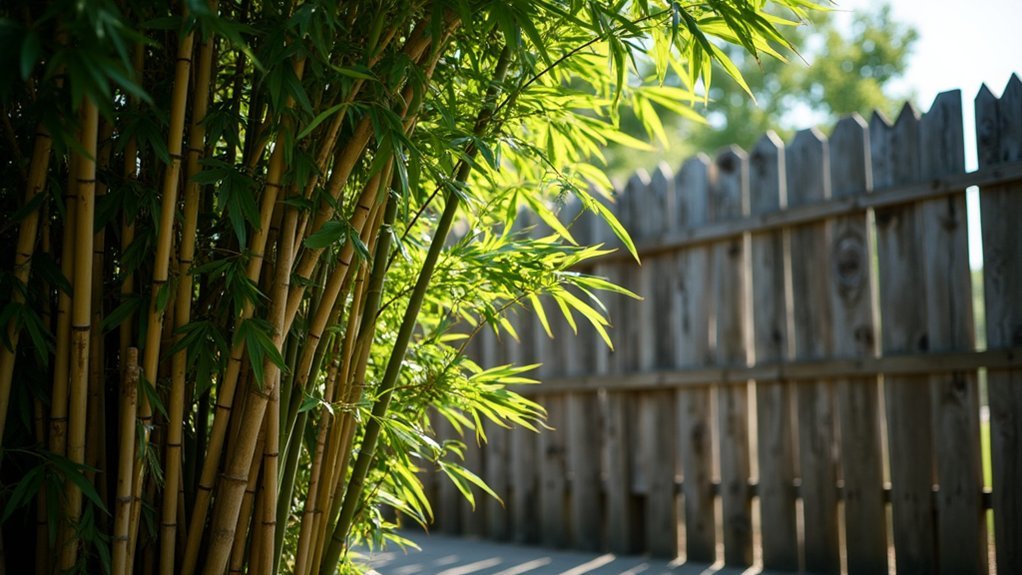
Real-world legal consequences can illustrate why proper barrier installation isn’t just a recommendation—it’s your financial protection.
The landmark case of Kings v. Sultans demonstrates this principle clearly. Despite planting bamboo before New York’s 2015 ban, the Kings faced liability of $57,149.38 when invasive bamboo root systems damaged their neighbors’ property.
The court rejected the Kings’ statute of limitations defense due to insufficient evidence, emphasizing that property owners must act promptly when bamboo encroaches on neighboring land.
Experts testified that simply mowing bamboo won’t prevent its spread—only proper excavation and barrier installation effectively contain it.
This case underscores your legal responsibility: failure to contain bamboo can constitute “substantial interference” with neighbors’ property enjoyment, leading to significant financial damages regardless of when you planted it.
Local Regulations and Bamboo Growth Restrictions
You’ll need to research your local zoning codes before planting bamboo, as many municipalities have established specific setback requirements ranging from 10 to 40 feet from property lines.
These regulations often require you to install proper containment barriers and may mandate regular maintenance to prevent encroachment onto neighboring properties.
In some areas, you’ll also need to complete a permit application process that includes submitting barrier specifications and a management plan before you’re allowed to grow bamboo on your property.
Zoning Code Compliance
Before installing bamboo barriers in urban areas, you’ll need to thoroughly research your local zoning codes, which often contain specific regulations about bamboo cultivation.
Since New York’s 2015 ban on running bamboo, many municipalities have adopted similar restrictions on invasive plants to prevent property damage and neighbor disputes.
Your zoning code compliance responsibilities typically include:
- Installing proper root barriers that meet specific depth and material requirements
- Maintaining bamboo growth within your property boundaries
- Following setback requirements that dictate minimum distances from property lines
Failure to comply with these regulations can result in fines, mandatory removal orders, or potential lawsuits from affected neighbors.
When planning your landscape, always verify current ordinances—they’re designed to protect community interests while still allowing you to enjoy non-invasive bamboo varieties with proper containment.
Setback Requirements Explained
While bamboo offers excellent privacy and aesthetic benefits in urban settings, understanding setback requirements is essential for legal compliance. Many local jurisdictions mandate specific distances between bamboo plantings and property boundaries, often requiring a minimum 10-foot buffer zone for running bamboo varieties.
These setback requirements serve an important purpose: preventing your bamboo from becoming a legal liability. When bamboo rhizomes cross property lines, you could face neighbour disputes, trespass claims, or nuisance lawsuits. The financial and social costs of such conflicts typically far exceed the effort of proper installation.
Before planting, consult your local zoning codes for specific setback regulations. Compliance not only protects you legally but also demonstrates respect for neighboring property owners’ rights—maintaining community harmony while still enjoying bamboo’s benefits in your urban landscape.
Permit Application Process
Beyond understanding setback requirements, traversing the permit application process forms a key aspect of legal bamboo cultivation in urban areas.
As a property owner in places like New York, where running bamboo is classified as invasive, you’ll need to comply with specific regulations before planting.
Your permit application typically requires:
- A detailed management plan showing how you’ll contain bamboo growth and prevent encroachment onto neighboring properties
- Documentation demonstrating compliance with local zoning laws that may restrict certain bamboo varieties
- Proof of notification to adjacent property owners about your intended bamboo cultivation
Stay informed about changing regulations, as laws regarding invasive species evolve frequently.
What’s permitted today might require additional documentation tomorrow.
Completing the permit application process correctly protects you from potential legal liability should your bamboo spread beyond your property boundaries.
Communicating With Neighbors About Bamboo Barriers
When installing bamboo barriers near property lines, proactive communication with your neighbors becomes essential for preventing disputes and fostering goodwill.
Approach your neighbors for an open conversation about bamboo’s invasive potential. Explain that running bamboo’s rhizomes can extend over 3 meters underground, potentially damaging their property if left uncontained. Simply mowing or clipping won’t stop the spread – only proper physical barriers will.
Suggest collaborating on bamboo root barrier installation as a shared investment that protects both properties. Mention any local regulations governing bamboo management to demonstrate your commitment to responsible cultivation.
Professional Installation vs. DIY Barrier Solutions
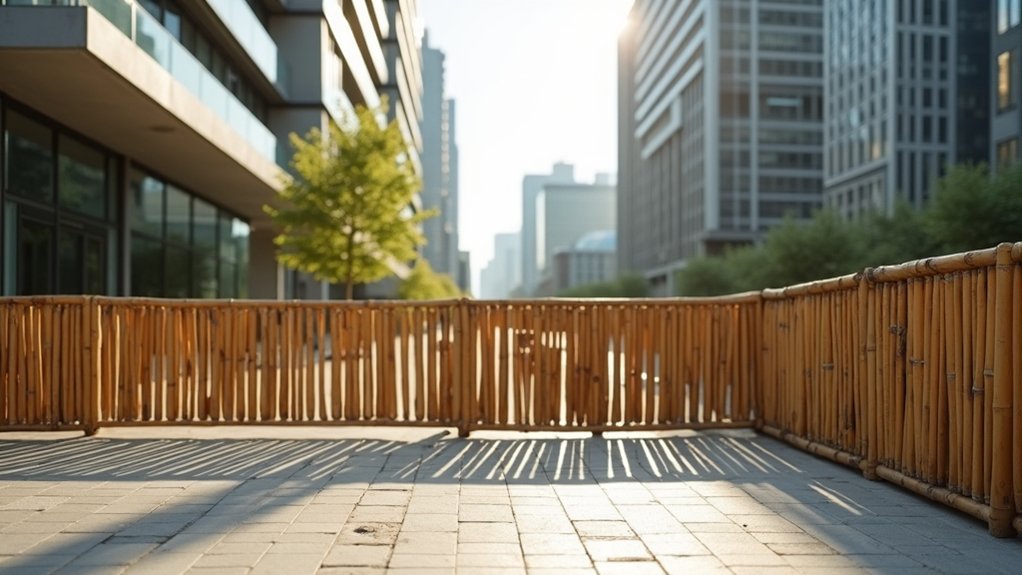
When considering bamboo barrier installation, you’ll face significant legal risks with DIY methods that often lack the precision needed to effectively contain invasive rhizomes.
Professional installers offer expert site assessment, high-quality materials like ribbed root barriers, and guaranteed compliance with local regulations—benefits that justify their higher upfront costs.
While DIY solutions appear cost-effective initially, they frequently lead to expensive remediation, neighbor disputes, and potential litigation when barriers fail, making professional installation a wise investment for long-term protection.
DIY Risks Assessment
Although installing bamboo barriers might seem like a straightforward weekend project, homeowners often underestimate the specialized knowledge required for effective containment.
Without professional experience, you’ll likely miss critical aspects of rhizome behavior, leading to ineffective barriers that fail to contain bamboo encroachment.
Key risks of DIY bamboo barrier installation include:
- Insufficient depth installation that allows rhizomes to spread underneath your barrier
- Non-compliance with local regulations, potentially creating legal liabilities if bamboo spreads to neighboring properties
- Lack of warranties or guarantees that professional services typically provide
While DIY approaches might seem cost-effective initially, improper installation can lead to significant expenses later, including property damage remediation and possible legal disputes.
Professional installers bring specialized tools, thorough site assessments, and knowledge of industry standards that DIY enthusiasts typically lack.
Professional Installation Benefits
Investing in professional bamboo barrier installation delivers significant advantages that DIY approaches simply can’t match.
When you hire experts, they’ll select the proper barrier type and installation depth to effectively contain invasive running bamboo with rhizomes that spread over 3 meters.
Professional installers bring knowledge of local regulations regarding invasive species, helping you avoid potential legal complications with neighbors or municipalities.
They possess specialized tools and techniques that guarantee proper barrier construction, dramatically reducing the risk of costly mistakes and future repairs.
Many professional bamboo installation companies offer warranties on their work, providing peace of mind that your barrier will perform effectively long-term.
This expertise assures compliance with industry best practices, protecting your landscape’s integrity and preventing reinfestation that could lead to disputes.
Cost-Effectiveness Comparison
Three key financial factors distinguish professional bamboo barrier installation from DIY approaches.
While DIY solutions initially appeal with their $200-$600 material costs compared to professional installation’s $1,500-$3,000 price tag, the long-term cost-effectiveness often favors professional services.
- Professionals provide warranties that protect your investment against future bamboo spread, potentially saving thousands in remediation costs.
- DIY installations require significant time investment—often multiple weekends—while professionals complete the job efficiently, minimizing property disruption.
- Improper DIY installation frequently leads to containment failures and costly fixes, negating initial savings.
When considering the legal and financial implications of bamboo spread to neighboring properties, professional installation offers peace of mind that may ultimately prove more economical than struggling with inadequate DIY barriers that fail to contain aggressive rhizomes.
Maintenance Requirements to Prevent Legal Disputes
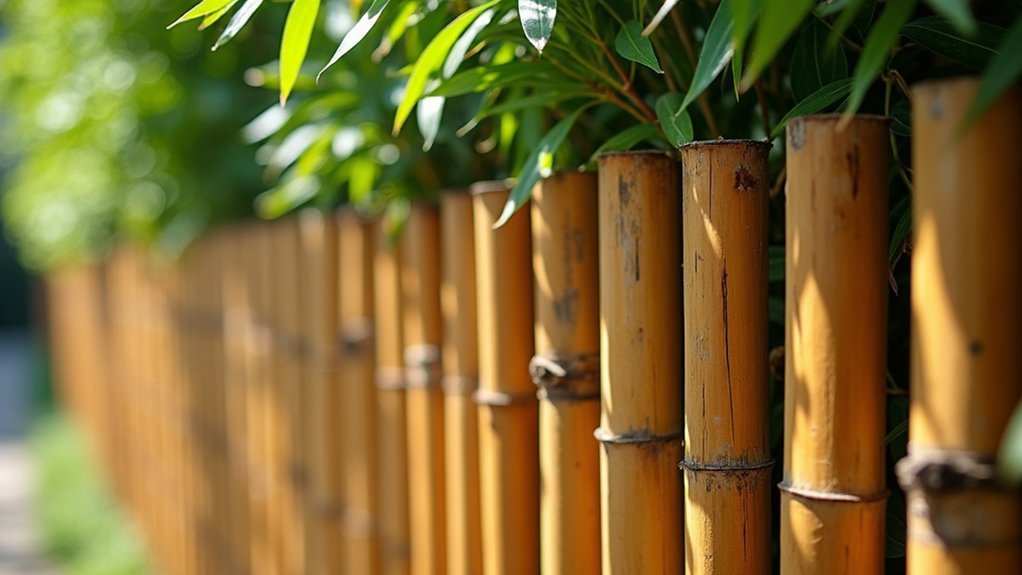
Because bamboo’s aggressive growth pattern presents unique challenges for urban property owners, proper maintenance isn’t merely a gardening concern—it’s a legal necessity.
You’ll need to conduct annual inspections to identify and remove any rhizomes attempting to cross your property line. Simply mowing or clipping won’t effectively eradicate bamboo—proper management requires excavation and complete root removal.
Document all your maintenance efforts with photographs and detailed records. This documentation serves as vital evidence if a neighbor raises legal concerns about root growth on their property.
Consider hiring a professional landscaper familiar with local regulations governing invasive species. Their expertise guarantees you’re complying with relevant laws while implementing best practices for containment.
A properly installed root barrier, combined with vigilant maintenance, will greatly reduce your risk of facing nuisance claims from adjoining property owners.
Documenting Bamboo Control Efforts for Legal Protection
While maintenance practices form your defense against bamboo invasion, extensive documentation strengthens your legal position when questions arise. When documenting bamboo control efforts, create a thorough record of all management activities, expenses, and communications related to your bamboo growing situation.
- Take time-stamped photographs before, during, and after removal to visually demonstrate the bamboo’s extent and your remediation work.
- Keep detailed logs of all maintenance dates, methods used, and costs incurred, including receipts from professional services.
- Maintain records of all neighbor communications regarding the bamboo, especially written agreements about containment responsibilities.
This documentation serves as vital evidence of your diligence should legal disputes arise, showing you’ve taken reasonable steps to control invasive bamboo and protect neighboring properties.
Liability Insurance for Bamboo Property Owners
Protection against potential bamboo-related disputes starts with the right insurance coverage. As a property owner with bamboo, you’ll need specialized liability insurance that specifically covers invasive plant species. Many standard policies exclude damages caused by bamboo encroachment, leaving you financially vulnerable to neighbor claims.
Bamboo ownership requires specialized liability coverage your standard policy likely excludes—protect yourself before disputes emerge.
When speaking with your insurance provider, explicitly mention your bamboo landscaping and ask about coverage limitations. Document all your bamboo management efforts—installation of root barriers, regular pruning, and neighbor communications—as these records can strengthen your defense against liability claims and potentially reduce your premiums.
Proactive bamboo containment not only demonstrates your commitment to responsible ownership but may also positively influence your insurance options.
Don’t wait for a dispute to arise; securing appropriate coverage now protects your financial interests later.
Remediation Options When Bamboo Crosses Boundaries
Three essential strategies exist for addressing bamboo that has already crossed property lines.
When your bamboo invades neighboring property, prompt action prevents legal disputes and costly damage claims. Document all remediation efforts as evidence of your responsible management.
- Immediate rhizome removal – Excavate all bamboo roots that have extended beyond your property boundary, cutting them back to your property line and installing a proper root barrier.
- Negotiated resolution – Work with your neighbor to develop a shared remediation plan, potentially offering to cover costs of professional removal services.
- Systematic containment – Apply targeted herbicide treatments to shoots emerging on neighboring property while simultaneously installing deep root barriers along your property line to prevent future spread.
Sustainable Alternatives to Invasive Bamboo Species
Many homeowners seeking privacy screens and decorative elements can avoid legal complications by choosing sustainable alternatives to invasive bamboo species.
Consider Fargesia and other clumping bamboo varieties that don’t exhibit the highly invasive nature of running bamboo types.
Native ornamental grasses and shrubs offer similar aesthetic benefits while supporting local ecosystems and biodiversity.
These sustainable alternatives won’t trigger the boundary disputes that often arise with aggressive bamboo varieties.
If you’re set on bamboo, always install root barriers—even with clumping species—to prevent unexpected spread.
Before making any landscaping decisions, check your local regulations regarding invasive plants.
Frequently Asked Questions
Is It Against the Law to Plant Bamboo?
Yes, it’s against the law to plant running bamboo in New York since the 2015 ban. You’re legally responsible for containing any existing bamboo on your property to prevent spreading to neighboring areas.
How Effective Are Bamboo Barriers?
Bamboo barriers are highly effective if you install them properly at 30+ inches deep. They’ll block underground rhizomes, but you’ll need to monitor them regularly for breaches and combine them with manual removal for best results.
How to Get Rid of Bamboo Invasion?
To get rid of bamboo invasion, you’ll need to cut canes at ground level and dig out all rhizomes. Regular mowing helps, but don’t forget to install deep root barriers. Always monitor for regrowth afterward.
What to Do if Neighbors Plant Bamboo?
If your neighbors plant bamboo, communicate your concerns immediately, suggest installing root barriers, document any encroachment, and research local regulations. You’ll need to monitor the growth closely to prevent unwanted spread onto your property.
In Summary
You’ve now learned how to navigate the legal maze of urban bamboo barriers. By selecting clumping varieties, installing proper root barriers, and documenting your control efforts, you’ll greatly reduce your liability risks. Remember, it’s your responsibility to prevent bamboo from crossing property lines. With proper management and the right knowledge, you can enjoy bamboo’s beauty without the legal headaches.





Leave a Reply